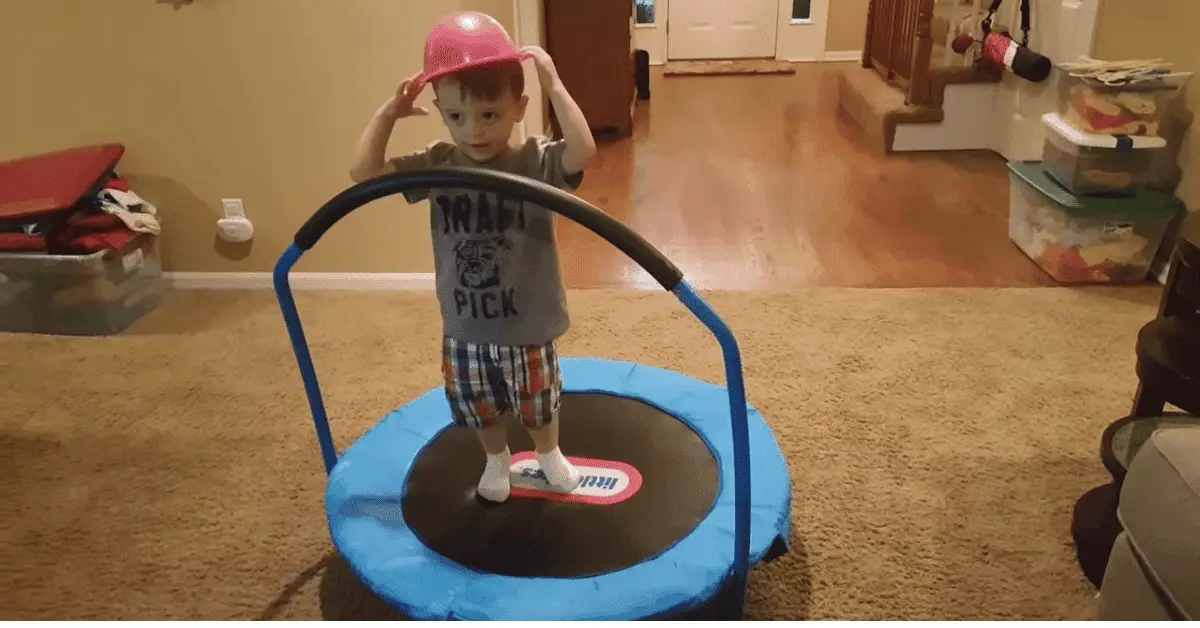If you’re looking for a way to let your little one burn off energy and have fun while staying active, a mini trampoline or rebounder can be a fantastic choice. But as a parent, you might wonder if “Are mini trampolines safe for toddlers?.”
Well, let me assure you that when certain precautions are taken, mini trampolines can provide toddlers with a safe and enjoyable experience.
To ensure safety, opting for a trampoline specifically designed with families in mind is crucial. Look for durable, durable materials free from small pieces that could pose a choking hazard.
Additionally, responsible use is key. Both you and your child should follow the recommended guidelines and safety measures.
While the typical age range for toddlers is considered to be between 1 and 3 years old, it’s worth noting that some mini trampolines are suitable for children as young as 6 years old.
However, always check the specific age recommendations the manufacturer provides before purchasing.
By selecting a well-designed trampoline, using it responsibly, and supervising your child’s playtime, you can create a safe environment where your toddler can enjoy the benefits of bouncing and exercise.
Are Mini Trampolines Safe for Toddlers: Mini trampolines can be safe for toddlers when used responsibly and with proper supervision, providing a fun and engaging way for them to stay active and develop their motor skills.
Are Mini Trampolines Safe for Toddlers?
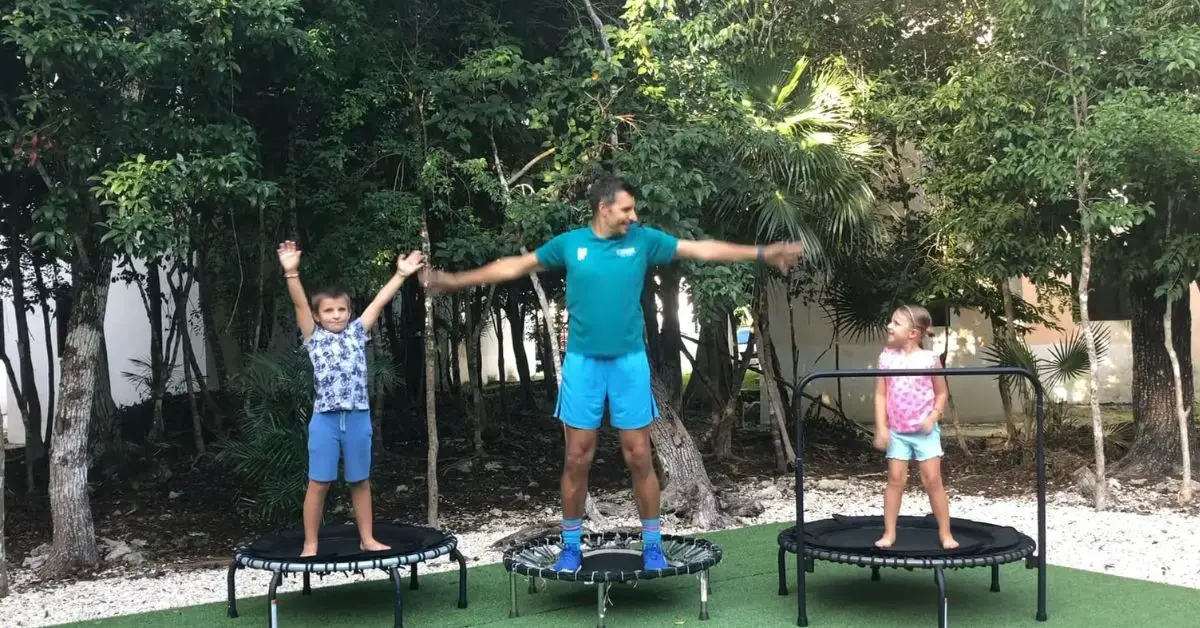
Mini trampolines can pose some risks for toddlers, so it’s generally advisable to wait until your child is at least 6 years old before allowing them to use one. However, if you still want to let your toddler use a mini trampoline, here are some important safety precautions to follow:
- Always supervise your child closely while they are on the trampoline to prevent accidents.
- Use a safety net around the trampoline to prevent falls and provide an extra layer of protection.
- Allow only one child at a time on the trampoline to avoid collisions and potential injuries.
- Use safety pads to cover the trampoline’s springs, hooks, and frame, reducing the risk of accidental bumps or entrapment.
Remember, these precautions can help mitigate the risks, but it’s still important to prioritize your child’s safety and make informed decisions based on their age, physical abilities, and overall readiness for trampoline use.
Is it safe for toddlers to use a mini trampoline?
If you’re searching for a way to help your toddler exercise and release their energy, a mini trampoline or rebounder can be a great option. But you might be wondering if these mini trampolines are safe for your little one.
As long as you choose a mini trampoline that is specifically designed for toddlers, made from high-quality materials without any small parts, and you and your child use it responsibly, trampolining can be completely safe.
While most people consider toddlers to be between the ages of 1 and 3, this article will also include children up to 6 years old.
In simpler terms, if you select the right mini trampoline and use it correctly, it can be a safe and enjoyable activity for your toddler to stay active and have fun.
Mini Trampolines for Toddlers: Benefits
Here are the benefits of a mini trampoline for toddlers:
Motor Skill Development:
Trampolines offer significant benefits for children’s perception and motor skills. When children jump on a trampoline, it stimulates their vestibular nervous system, which provides information to the brain about their body’s position and spatial awareness.
This means that jumping on a trampoline helps children develop a better sense of balance and coordination. It also improves their ability to judge distances and navigate their surroundings more effectively.
So, apart from being a fun activity, trampolines can contribute to the overall development of children’s motor skills and enhance their spatial awareness.
Enhancing Driving Skills:
Trampolines have a positive impact on children’s perception and motor abilities. Children jumping on a trampoline directly affects their vestibular nerve system. This system sends signals to the brain, providing information about the body’s position and spatial awareness.
Jumping on a trampoline helps children develop better balance, coordination, and a greater sense of their surroundings. It enhances their ability to judge distances and navigate their environment more effectively.
In simpler terms, trampolines are not only a fun activity but also contribute to improving children’s motor skills and their understanding of space and movement.
Boosting Energy Levels:
When children bounce on a mini trampoline, it directly impacts their bodies. It increases the amount of oxygen carried in their bloodstream, resulting in a boost of energy. This sudden surge of energy makes them feel more awake and refreshed immediately.
By engaging in trampoline exercises, you can give your kids a significant energy boost that can help them stay active and vibrant throughout the day.
So, if you want to give your children an extra burst of energy, getting them to exercise on a mini trampoline can be a great way to do it!
Enhancing Heart Health:
Trampolines offer a wonderful exercise option for kids, especially when they don’t have access to an outdoor yard. Jumping on a trampoline allows children to release their energy while also keeping their heart rate elevated.
It provides an excellent cardiovascular workout that can contribute to improved heart health. It’s no wonder trampolines have been popular in the past—they offer a fun and effective way to engage in physical activity and promote a healthy heart.
So, if you’re looking for an enjoyable way for your kids to stay active and benefit their cardiovascular system, trampolining is a fantastic choice.
Promoting Happiness in Children:
Jumping on a trampoline brings joy to everyone, and there’s a scientific reason behind it. When we jump, our bodies release endorphins, which are natural mood enhancers.
This boost in endorphins leads to increased feelings of happiness and overall well-being. Moreover, bouncing on a trampoline improves oxygen circulation throughout the body, contributing to a positive mood.
For children, jumping on a trampoline is a fun activity and a great way to relax and unwind after a long day. The act of rebounding on the trampoline helps improve sensory abilities as it requires concentration, provides enjoyment, and involves repetitive movements.
This combination of physical activity, sensory engagement, and enjoyment can leave children feeling happier and more fulfilled.
So, if you want to bring a smile to your child’s face and boost their mood, let them experience the joy of bouncing on a trampoline. It’s a wonderful way to promote happiness and provide a fun outlet for them to release their energy.
Boosting Confidence:
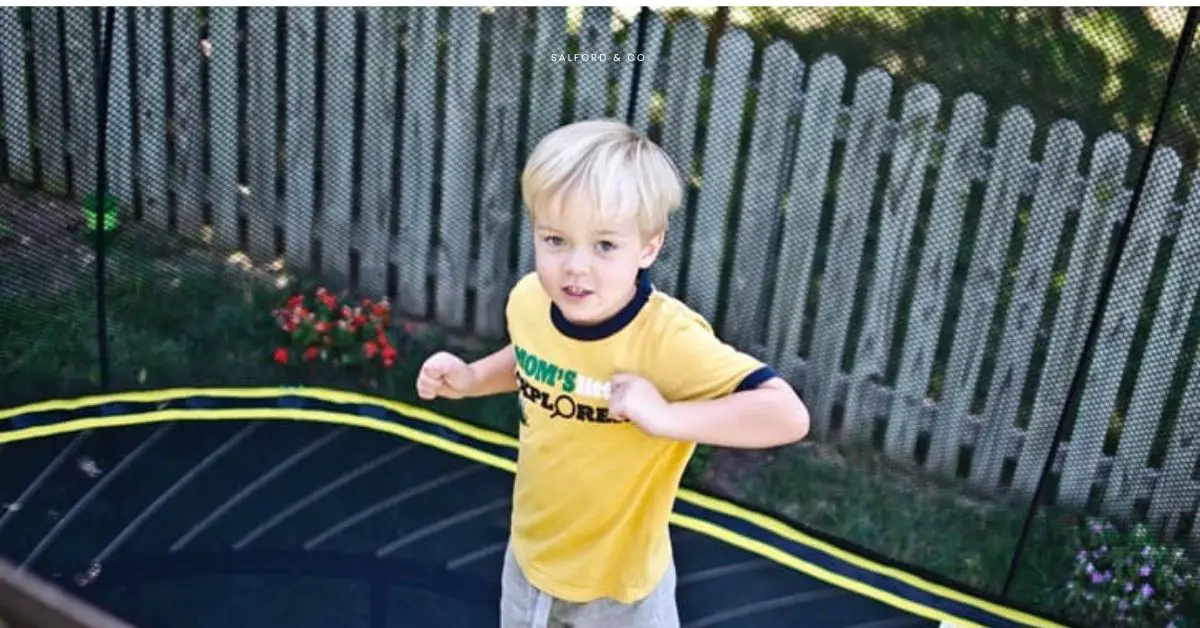
Trampolines can be an excellent tool for helping children who may be hesitant or fearful of new activities to build up their confidence.
The beauty of trampolines lies in the variety of movements one can perform on them, as long as they are done safely.
This allows children to experience immediate success, boosting their courage and self-confidence.
The diverse range of movements possible on a trampoline, such as jumping, bouncing, and even simple exercises, provides children with a sense of achievement.
They can try different movements at their own pace and gradually overcome any initial fears or doubts. As children master these movements and realize their capabilities, their confidence grows.
Trampolines create a safe and supportive environment where children can explore their physical abilities and discover their own strengths. This sense of accomplishment and confidence gained through trampolining can also positively impact other areas of their lives.
So, if you have a child who is hesitant or needs a confidence boost, introducing them to a mini trampoline can be a wonderful way to help them overcome their fears and develop a stronger sense of self-assurance.
Fostering Focus with Low-Impact Activity:
Jumping on a trampoline can also positively impact children’s ability to concentrate. Research suggests that jumping helps relax the brain through physical exertion while less taxing on the body than activities like running or jogging.
Jumping on a trampoline is considered a moderate activity that offers various physical benefits for children, such as improving coordination, overall health, and focus. The controlled bouncing motion on mini trampolines allows children to engage in this activity even when space is limited.
By incorporating trampolining into their routine, children can experience the benefits of increased focus and concentration. The rhythmic bouncing and physical activity help stimulate the brain, allowing it to function more efficiently and enhance concentration abilities.
So, if you’re looking for a low-impact activity to support your child’s focus and concentration, mini trampolines provide an enjoyable and space-efficient option.
Fun and Engaging Playtime:
Engaging your toddler in fun and interactive playtime is essential for their development and overall happiness. Mini trampolines offer a fantastic opportunity to create a lively and enjoyable play environment for your little one.
With a mini trampoline, your child can experience the joy of bouncing, jumping, and even trying out simple exercises. The act of bouncing on the trampoline brings a sense of thrill and excitement, making playtime more engaging and entertaining.
Not only does jumping on a trampoline provide a fun-filled experience, but it also offers numerous physical benefits. It helps improve coordination, balance, and motor skills while allowing your child to release excess energy and enjoy healthy exercise.
Additionally, mini trampolines can be used both indoors and outdoors, making playtime accessible in any weather conditions. Whether your toddler bounces solo or engages in play with siblings or friends, the mini trampoline offers a versatile platform for interactive play.
So, by incorporating a mini trampoline into your toddler’s playtime routine, you can create a dynamic and enjoyable experience that promotes their physical, cognitive, and social development. It’s a wonderful way to make playtime more fun and engaging for your little one.
Are Mini Trampolines Dangerous for Toddlers?
Yes, mini trampolines can be dangerous for toddlers. It’s crucial to be aware of the potential risks and take necessary precautions to keep your child safe while using a mini trampoline.
Potential Impact on Growth Plates:
The growth plate is a crucial part of children’s bones. It consists of soft cartilage tissues that surround the ends of their bones. As children grow, these tissues transform into solid bones, allowing the bones to become longer and support their growing weight.
However, if the growth plate is injured or fractured, it can have long-term effects on how the bone develops in the future.
The growth plate is vulnerable to damage, especially in children whose bones are still growing. Injuries to the growth plate can disrupt the normal growth process and potentially lead to complications.
It’s important to be cautious when using mini trampolines, as improper landings or excessive force on the bones can increase the risk of injury to the growth plates.
To prevent potential harm to the growth plates, it’s crucial to supervise toddlers closely while they use mini trampolines and ensure they are using the trampoline in a safe manner.
It’s also advisable to follow age recommendations and guidelines provided by the manufacturer to minimize the risk of injuries that could impact the growth plates.
By being mindful of the growth plates and taking necessary precautions, we can help safeguard our children’s bones’ proper development and growth.
Injury Risks:
Engaging in trampoline activities poses the risk of various injuries, including sprains and fractures in the arms and legs and head and neck injuries. These injuries can occur due to falls, improper landings, or collisions with other objects or individuals while using a mini trampoline.
To ensure the safety of toddlers, the American Academy of Pediatrics strongly advises against using trampolines at home. The organization recognizes the increased risk of injury associated with trampoline use, particularly among young children.
In order to protect your child from potential harm, it is essential to prioritize their safety and heed the advice of medical professionals. Instead of using a mini trampoline, consider alternative activities that provide similar benefits without the same level of risk.
Choosing safer alternatives and providing appropriate supervision and guidance during playtime can help prevent injuries and create a secure environment for your child’s physical activity.
Improving Coordination:
The lack of coordination is a common concern when it comes to using mini trampolines for toddlers. Coordination indeed improves with practice, but engaging in trampoline activities also carries a risk of injury. It’s important to find a balance and approach this situation based on your own judgment.
While there is a small risk involved, many parents choose to let their children experience the exercise and benefits of using a mini trampoline under close supervision.
By being fully present and monitoring their child’s movements, parents can help ensure their safety during trampoline play.
Supervision is key in minimizing the risk of injuries and providing a safe environment for your child to develop coordination skills. By closely observing their actions and offering guidance, you can help your child navigate the trampoline safely and gradually improve their coordination over time.
Ultimately, the decision to allow your child to use a mini trampoline should be based on your comfort level and your ability to provide proper supervision.
By weighing the risks and taking necessary precautions, you can support your child’s development while keeping their safety as a top priority.
What are the typical injuries associated with trampoline use?
It’s important to recognize that injuries can occur while playing on a trampoline. Although the risk of injuries is generally lower on a mini trampoline, it’s still essential to be aware of potential risks.
Here are some of the most common trampoline injuries:
- Bruises are common and can result from bumping or landing on the trampoline surface.
- Sprains: Overstretching or tearing of ligaments can happen when landing improperly or experiencing a sudden twist on the trampoline.
- Strains: Strains occur when muscles or tendons are stretched or torn due to forceful movements on the trampoline.
- Fractures: A bone can break due to falls, collisions, or landing with excessive force on the trampoline.
- Cuts: Sharp edges or objects on the trampoline can cause cuts or abrasions if proper precautions are not taken.
- Dislocation: A joint can become dislocated if it is forced out of its normal position during trampoline activities.
- Concussion: A blow to the head can result in a concussion, a mild traumatic brain injury requiring medical attention.
To minimize the risk of these injuries, it is important to follow safety guidelines, supervise children closely, and ensure that the trampoline is in good condition. Taking appropriate precautions can help promote a safer trampoline experience for everyone involved.
Major Causes of Trampoline Injuries
The majority of trampoline injuries can be attributed to the following causes:
- Too many people on one trampoline: When multiple individuals, especially children, jump on a trampoline simultaneously, collisions and accidents are more likely to occur. The increased activity and unpredictable movements can lead to injuries.
- Falling off the trampoline: If a person loses their balance or jumps too close to the trampoline’s edge, they can fall off and sustain injuries. The impact from landing on the ground or other objects can cause bruises, sprains, or fractures.
- Attempting “stunts” such as somersaults: Trying to perform flips, somersaults, or other advanced maneuvers on a trampoline without proper training and supervision can be dangerous. Lack of control or incorrect landing techniques can result in head, neck, or limb injuries.
- Forceful contact with metal parts such as rails: Trampolines typically have metal frames, springs, or rails that can pose a risk if individuals come into forceful contact with them. Colliding with these metal parts can lead to bruises, cuts, or even more severe injuries.
Understanding these common causes of trampoline injuries is important to take appropriate precautions. Following safety guidelines, using trampolines responsibly, and providing supervision can help reduce the risk of accidents and promote a safer trampoline experience for everyone.
How can falls and injuries related to trampolines be prevented?
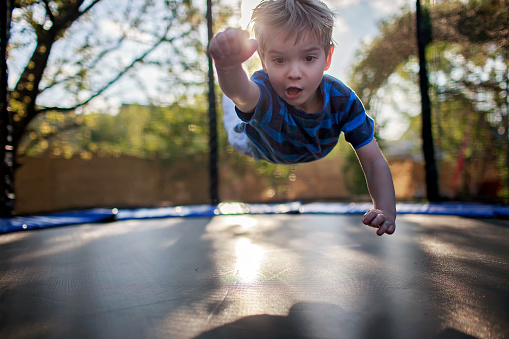
We want to ensure our children’s safety while still allowing them to engage in activities and learn through play.
In trampoline use, completely eliminating the activity may not be necessary.
Instead, implementing preventive measures can help create a safer environment for your child.
Allowing Only One Person:
Using a mini trampoline may not leave much space for multiple children to jump together, but that doesn’t stop them from trying!
Kids can be adventurous and may attempt to share the trampoline despite its size limitations. Establishing clear ground rules regarding its usage is important to ensure their safety.
Utilize Safety Nets and Padding for Added Protection:
While safety nets are typically more relevant for regular trampolines used by older children, there are still ways to enhance safety on mini trampolines. One effective measure is to place padding around the trampoline to cushion any potential falls.
Active Supervision:
Implementing adult supervision is crucial when allowing our children to use a trampoline. It should be a no-brainer to ensure someone responsible is present and actively watching over them.
This supervision is necessary to monitor their safety closely and intervene if any risky situations arise.
Opt for Ground-Level:
It’s important to be cautious and avoid the temptation of placing a mini trampoline above ground level, such as on a deck. This can significantly increase the risk of severe injuries if a child accidentally falls off. Instead, prioritize keeping the trampoline at ground level for enhanced safety.
Perform Pre-Activity Safety Checks:
Don’t forget to prioritize the crucial step of inspecting the trampoline before allowing your child to use it. Trampolines can experience wear and tear; certain parts may loosen or sustain damage over time.
Always make it a habit to thoroughly examine the trampoline to ensure it is in proper working condition before your child begins to play. This pre-activity check is essential for their safety and helps prevent any potential accidents or injuries.
Avoid Jumping Off the Trampoline:
Children often enjoy imitating and taking unnecessary risks, so our supervision is crucial. While it may seem exciting to try jumping off the trampoline, it poses a significant risk of slipping and potentially injuring their ankles or causing more severe harm.
To ensure their safety, it is essential to establish clear ground rules about not jumping off the trampoline. By setting these boundaries, we can help prevent accidents and injuries while they are using the trampoline.
Establish an Age Limit for Trampoline Usage:
It is recommended that children under the age of 6 should not use the trampoline. At this stage, their muscles and physical development may not be sufficient for engaging in such activities safely.
However, the final decision rests with you as a parent or guardian. If you choose to allow younger children to use the trampoline, it is advisable to supervise them closely and limit their bouncing to gentle movements while providing hand-holding support.
This cautious approach can help minimize any potential risks and ensure a safer trampoline experience for younger children.
What sets mini trampolines apart from regular trampolines?
Mini trampolines differ from regular trampolines in several ways.
Age-Appropriate Design:
Trampolines designed for children come in various sizes and weight capacities. Most of them are suitable for toddlers aged three to six, weighing less than 60 pounds.
Choosing a mini trampoline that aligns with your child’s age and weight is important based on these guidelines. Considering your child’s future weight and age can also be beneficial if you want them to be able to use the trampoline for an extended period.
With a wide range of options, selecting the appropriate trampoline will ensure your child’s safety and enjoyment while using it for years.
Implementing Safety Measures for Mini Trampolines:
Mini trampolines are designed with safety in mind, making them different from regular outdoor trampolines. They have a smaller bouncing surface and are closer to the ground, greatly reducing the risk of falling off.
To ensure safety, mini trampolines have soft padding that covers the springs and gaps around the edges. This prevents the pinching of hands and feet while bouncing.
Unlike traditional trampolines that use metal springs, many toddler trampolines now utilize elastic cables to connect the bouncing surface to the frame. This eliminates the risk of being pinched by springs.
The frames of mini trampolines are made of sturdy steel, ensuring they can safely accommodate children of all sizes. Additionally, most mini trampolines come with a safety handrail.
This handrail helps children maintain balance and confidence as they learn to use the trampoline or try new skills. The height of the handrail can be adjusted to accommodate the child’s growth over time.
Is it safe to allow a two-year-old to play on a trampoline?
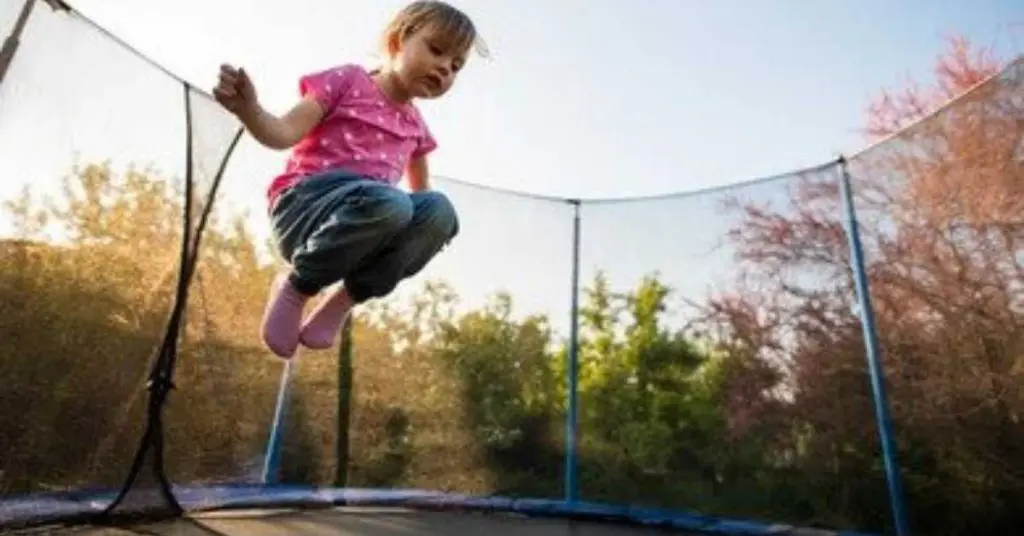
The American Academy of Pediatrics advises against allowing children under the age of six to use trampolines.
While it may be disappointing for young children, using a trampoline at such a young age can lead to significant injuries, particularly to the head and neck.
Most Common Trampoline Injuries?
Between 1991 and 1999, more than 100,000 people had to go to the hospital because of injuries from trampolines. During that time, there were also 11 deaths related to trampoline accidents.
The most common types of trampoline injuries are fractures in the hands, elbows, feet, and spine. These injuries often occur when children attempt risky flips and stunts or when they accidentally collide with each other while jumping. Concussions are also common due to falls on the trampoline mat.
According to a study, the main causes of trampoline injuries are uncomfortable landings, falls, contact with other jumpers, and attempting risky somersaults.
However, it doesn’t mean that trampolines are completely off-limits for toddlers. Mini-trampolines can still be used with proper precautions.
It’s important to have adult supervision at all times, avoid flips and gymnastic tricks, ensure thick padding on the rails, and use a safety net around the trampoline. Placing the trampoline on a flat and soft surface is also recommended.
Potential Causes of Trampoline Injuries
Factors contributing to trampoline injuries:
Trampoline-Related Accidents:
If the trampoline doesn’t have a proper safety net surrounding it, your toddler may jump too high and land on the ground. This can result in broken bones if pebbles or other hard objects are on the ground.
Risk of Extreme Moves and Stunts:
Energetic and enthusiastic kids. It’s not uncommon for one of them to get carried away and attempt gymnastics flips or stunts that can result in injuries, despite your efforts to encourage them to be more cautious.
Trampoline Overcrowding and Multiple Users:
Trampoline overcrowding and multiple users can lead to dangerous situations, especially for younger and more vulnerable children. When kids of various ages and sizes jump together, they may unintentionally collide, squeeze each other’s muscles, and cause injuries.
This can be particularly risky for a two-year-old, especially if they have autism. Even on indoor mini-trampolines, having too many children jumping simultaneously has been associated with injuries in young kids.
It’s important to ensure a safe environment and appropriate supervision to prevent such incidents.
Unintentional Harm Caused by Metal Parts and Railings:
The trampoline’s structure includes rails and metal parts that can accidentally cause harm to users. To prevent such injuries, it is important to ensure sufficient foam padding is in place.
Tips for Trampoline Safety
If you decide to let your kids use a trampoline, it’s important to prioritize safety. While trampolines can be risky, you can greatly reduce the dangers by following some simple rules.
One important rule is to allow only one person on the trampoline at a time. This helps to minimize the most common cause of trampoline injuries.
To manage turns effectively, you can establish a code word or a specific time frame for each jumper so everyone knows when it’s their turn to use the trampoline. Implementing these safety measures can make trampoline play safer for your kids.
Limit Jumping:
- Trampoline use is limited to one person at a time.
- Children under six should not use the trampoline.
- Don’t allow dangerous tricks like somersaults without adult supervision, proper learning, and wearing a harness.
Invest in Protective Gear:
- Get padding to cover the trampoline’s metal parts, springs, and hooks for safety.
- Check the padding regularly for any signs of damage or wear, and replace it if needed.
- Install a net enclosure around the trampoline as an added safety measure.
- Read the manual carefully to ensure proper installation of the net enclosure.
- Do not allow children to hang from or climb up the net.
Constant Adult Supervision:
- Make sure there is a comfortable spot for adults to relax and supervise the children on the trampoline.
- Regularly check the trampoline for any damage or wear to ensure it is safe for use.
- Come up with creative activities to keep the children entertained on the trampoline.
- Instead of allowing somersaults and tricks, encourage activities like jumping and throwing a ball at a target or playing basketball.
- Play a “memory game” where children mimic the player’s actions in front of them for fun and coordination.
Consider Child’s Temperament:
Following simple guidelines can greatly reduce the risk of injuries while using a trampoline. Trampolines are a fun way for children to stay active and healthy, but it’s important for your child to listen and follow the rules to ensure their safety.
Jumping with Supervision Only:
If you have a ladder for the trampoline, remember to remove it after each use. This will help prevent young children from getting on the trampoline without supervision.
Careful Trampoline Placement:
Before setting up a trampoline, make sure to prepare the area properly. Choose a flat surface away from trees or buildings.
Create separate waiting areas for kids so they don’t disturb each other. If your trampoline doesn’t have a built-in enclosure, you can easily set up a temporary viewing area nearby. Remember to consider the perspective of children when designing the play area.
Stay Informed:
Ensure that your homeowner’s insurance covers injuries related to trampolines. To stay informed about any recalls or customer complaints regarding your trampoline, regularly search on saferproducts.gov using the brand and model of the product.
Avoid Small Trampolines:
The AAP advises against buying mini trampolines due to similar safety concerns as with full-sized trampolines.
Indoor Trampoline Positioning:
To prevent injuries, it’s important to keep the trampoline away from potential dangers like trees. Falls from a higher level can increase the risk of injury, so maintaining a safe distance from such hazards is crucial for trampoline safety.
Using Pads and Nets:
To ensure safety, use protective padding on the trampoline’s frame, springs, and nearby hard surfaces. Set up an enclosure around the trampoline for complete coverage. Regularly inspect the equipment for any signs of wear or damage.
Prohibit Flips and Somersaults:
It’s important to prevent your kids, regardless of their age, from attempting risky tricks on the trampoline. These stunts greatly increase the risk of severe head, neck, or spinal cord injuries, which can have long-lasting or even fatal consequences.
Are Indoor Trampolines for Kids Safe or Risky?
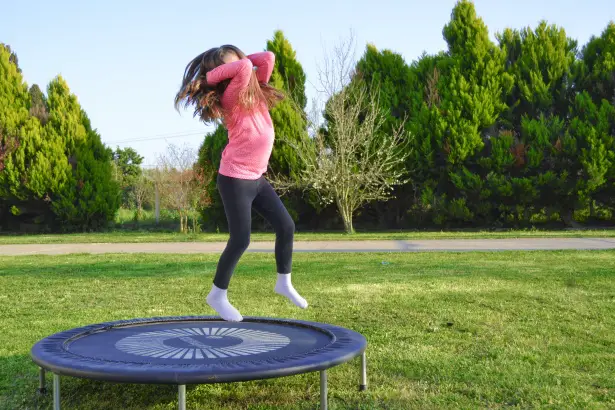
Are Indoor Trampolines Safe for Kids, or Do They Pose Risks? Trampolines can be fun, but it’s important to consider both the benefits and potential dangers before deciding if they suit your family.
Let’s examine the pros and cons of making an informed decision.
Understanding the Risk of Trampolines:
One of the main problems with trampolines is that it’s difficult to determine the level of risk involved accurately. We have data on how many children ended up in the emergency room due to trampoline accidents. Still, we don’t know how many children have access to swing sets or how often they typically use trampolines.
Trampoline statistics often focus on large outdoor playgrounds where multiple children can jump together. Common injuries include accidents from falling or colliding with others and injuries from attempting dangerous stunts.
Exploring the Advantages of Indoor Trampolines:
Trampolines are a great way for kids to exercise, especially if they don’t have access to an outdoor yard. Jumping on a trampoline is fun and provides a good cardiovascular workout. It helps improve children’s motor skills and body awareness.
Jumping stimulates the vestibular system, which helps with balance and coordination. It can also help children concentrate and reduce stress. Mini trampolines are a compact option for kids to enjoy the benefits of exercise and fun without taking up much space.
Ensuring Safe Usage of Indoor Trampolines:
While trampoline time can benefit your child’s health and development, setting some rules and safety measures in place is crucial. Before bringing a large trampoline inside your home, make sure to take certain precautions.
Patience for Your Child’s Age:
To make it safer, wait until your child is older and has better control of their body. It’s best to avoid indoor trampolines until the child is at least four years old. Consider using a trampoline with a handle for extra support for younger children.
Limiting Exposure to Trampoline Activities:
Instead of keeping the trampoline in your child’s bedroom, choose a central location that is easy to reach. This way, your child can access it safely and avoid accidents.
Only allow one child to jump at a time unless you supervise, and ensure everyone understands the rules. Follow the weight guidelines the manufacturer provides and ensure that the trampoline is placed away from sharp or hard objects to keep your child safe.
Considering the Drawbacks of Indoor Trampoline Play:
For children under six years old, indoor trampolines can be very dangerous. The American Academy of Pediatrics advises against having a trampoline at all because of the high risk of injury for young children. While most safety tips focus on outdoor trampolines, they can still apply to indoor ones.
Young children don’t have the physical ability or control to use a trampoline safely, which can lead to accidents from flips or falls. Some indoor trampolines have a handle for children to hold onto, but adult supervision is still necessary to prevent injuries to their teeth or other body parts.
There isn’t enough information available to help parents make the best decision, and this is a concern for many organizations.
Trampoline statistics only provide a small part of the story, and there is even less information about indoor trampolines. Some risks are unavoidable during childhood, but being aware of them can help you prepare.
If you have multiple children or your child is very young or has developmental difficulties, an indoor trampoline may not be worth the effort and risks involved.
Maintaining Continuous Vigilance:
It’s important to supervise how people use the space, even if it’s a public area. Your child’s safety relies on your presence and ability to stop any activity if needed. Talk with your child about what behavior is appropriate and what is not.
Single User and Lower Height:
This is not the right place to perform or show off. Even though indoor gyms are more convenient, parents should not ignore the dangers their children may encounter while playing there.
Indoor gyms are easily accessible, whether they are placed on a coffee table or in your child’s room. As a result, parents may be less likely to closely supervise their kids.
Are Mini Trampolines Safe for Adults?
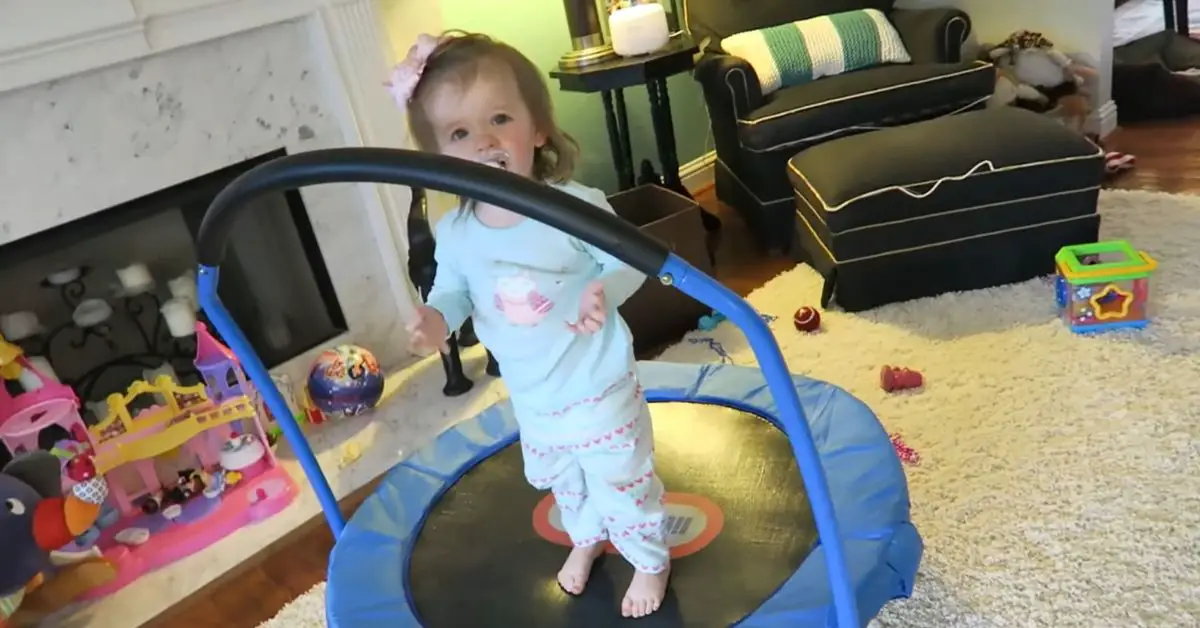
Yes, mini trampolines can be safe for adults if used properly. It’s important to choose a sturdy model, follow safety guidelines, and ensure that the weight limit is appropriate for adult use.
Are Trampolines Safe for 2-Year-Olds?
Trampolines are generally not considered safe for 2-year-olds. The American Academy of Pediatrics advises against trampoline use for children of that age due to their lack of coordination and increased risk of injury.
Are Trampolines Safe for 3-year olds?
Trampolines are not considered safe for 3-year-olds. Young children have a higher risk of injuries due to their lack of coordination and development. Adult supervision and safety measures are crucial for trampoline use.
Are Trampolines Safe for 4-Year-Olds?
Trampolines still pose a risk for 4-year-olds. While they may have better coordination than younger children, supervision and safety precautions are necessary to minimize the chance of injuries.
Are Trampolines Bad for Children’s Joints?
There is a potential risk of joint injuries when using trampolines, especially if proper safety measures are not followed. Excessive or incorrect jumping techniques can strain children’s joints and lead to potential long-term issues.
Alternative Options for Toddler Play
There are several alternative options for toddler play that provide a safe and engaging experience:
- Playground: Take your toddler to a local playground equipped with age-appropriate structures like slides, swings, and climbing frames.
- Sensory play: Set up sensory bins or tables with materials like sand, water, or rice for your toddler to explore textures, colors, and shapes.
- Arts and crafts: Engage your child in creative activities such as drawing, painting, or crafting with safe materials like crayons, finger paints, or play dough.
- Storytime and pretend play: Read books together and encourage imaginative play by setting up a pretend kitchen, doctor’s office, or dollhouse.
- Nature walks: Explore parks or nature trails with your toddler, allowing them to observe and interact with the environment, such as collecting leaves or spotting wildlife.
- Music and dance: Encourage movement and expression through music and dance activities like singing, playing instruments, or having a dance party at home.
- Indoor play spaces: Look for indoor play areas specifically designed for young children, offering soft play structures, ball pits, and interactive games.
Remember to supervise your toddler during playtime and ensure that the activities suit their age and developmental stage.
Guidelines for Safe Toddler Trampoline Usage
Guidelines for safe toddler trampoline usage are crucial to minimize the risk of injuries and ensure a positive and enjoyable experience. Here are some important guidelines to follow:
Age-Appropriate Use:
Ensure that your toddler is at an appropriate age for using a mini trampoline. Most experts recommend waiting until a child is at least three years old.
Supervision:
Never allow your toddler to use the trampoline without constant adult supervision. Keep a watchful eye on them at all times to prevent accidents.
Quality and Stability:
Purchase a mini trampoline designed for toddlers that meets safety standards. Ensure it has a stable frame and sturdy construction.
Proper Setup:
Follow the manufacturer’s instructions carefully when setting up the trampoline. Ensure it’s placed on a flat, level surface, away from obstacles or hazards.
Maintenance and Safety Checks:
Regularly inspect the trampoline for any wear and tear, loose parts, or damaged springs. Address any issues promptly to maintain its safety.
Safety Accessories:
Consider using safety accessories like a safety net, padding, or handrails to reduce the risk of falls and injuries. Ensure they are properly installed and well-maintained.
User Limitations:
Limit the number of children using the trampoline simultaneously to avoid collisions and accidents. Follow the manufacturer’s guidelines for weight limits.
Proper Footwear:
Ensure your toddler wears non-slip socks or appropriate footwear with grip when using the trampoline. This helps prevent slipping.
Warm-Up Exercises:
Before trampoline use, engage in light warm-up exercises to prepare your toddler’s muscles and joints for activity. Simple stretching or jumping jacks can help.
Safe Jumping Techniques:
Teach your toddler how to jump safely with both feet, land with slightly bent knees, and avoid jumping too high. Encourage controlled and gentle bouncing.
Time and Frequency:
Limit trampoline use to short sessions, typically no more than 10-15 minutes at a time, and take breaks in between to prevent fatigue.
Signs of Fatigue or Discomfort:
Be attentive to signs that your toddler may be tired or uncomfortable, such as heavy breathing, slowing down, or expressing discomfort. Encourage breaks when needed.
No Stunts or Rough Play:
Emphasize that acrobatics, flips, or rough play are not allowed on the trampoline. These activities significantly increase the risk of injury.
No Toys or Objects:
Discourage your toddler from bringing toys or objects onto the trampoline, as they can create tripping hazards.
Exit Safely:
Teach your toddler how to exit the trampoline safely by walking to the edge and holding onto the handrail or safety net for support.
Regular Safety Talks:
Have regular conversations with your toddler about trampoline safety, emphasizing the importance of following the rules and being cautious.
Emergency Plan:
Have an emergency plan in place in case of an accident. Know how to contact medical professionals quickly if needed.
By following these guidelines, parents and caregivers can help ensure a safe and enjoyable experience for toddlers using mini trampolines while minimizing the risk of injuries.
Remember that safety should always be a top priority when it comes to any physical activity for young children.
Related article: How To Avoid In-Ground Trampoline Snakes
FAQs:
Q:1 Is a mini trampoline appropriate for a 2-year-old?
Trampolines are not a good idea for children who are younger than 6 years old. The reason is that their bones are still growing and are more flexible, so jumping on a trampoline can hurt their bones, joints, or the areas where their bones are growing.
It’s better to wait until they are older and their bodies are more developed before letting them use a trampoline.
Q:2 At what age is it considered safe for children to use mini trampolines?
Experts and trampoline manufacturers advise that children under the age of six should not use trampolines. This is because their bones are still delicate and growing, making them more vulnerable to injuries caused by jumping. Additionally, their smaller bodies are more at risk of getting hurt while using a trampoline.
Q:3 Can a 3-year-old safely use a trampoline?
If your child is a baby, toddler, or under six years old, it’s important not to let them use a trampoline. Their bodies are not yet fully developed to handle bouncing safely.
Always have a safety net around the trampoline to prevent falls. Make sure to supervise your child closely while they are on the trampoline and ensure they take breaks from jumping to rest.
Q:4 What size trampoline is recommended for a 3-year-old?
Here’s a simplified version of the trampoline size guide:
- For 2-year-olds and 3-year-olds, a toddler or mini trampoline is suitable.
- For 4-year-olds, a mini trampoline, a 4.5ft trampoline, or a 6ft trampoline can be used.
- For 5-year-olds, a 6ft trampoline or an 8ft trampoline is recommended.
Q:5 How do trampolines affect child development?
Trampolining can help kids calm down and focus better, improving their learning ability. Trampolines can also be a fun and effective way for kids to learn new things.
Conclusion:
In conclusion, while mini trampolines may seem appealing for toddlers, they have inherent risks and safety considerations. It is important to prioritize the well-being of toddlers and make informed decisions regarding their safety.
Mini trampolines are not recommended for toddlers due to their young age, limited coordination, and the potential for injuries. Toddlers’ developing bones and joints are more susceptible to damage from the repetitive jumping motions associated with trampolines.
To ensure the safety of toddlers during playtime, alternative options such as foam pit play areas, inflatable bounce houses, and age-appropriate playgrounds should be explored.
These alternatives provide engaging and stimulating environments while minimizing the risk of injuries. It is crucial to provide appropriate supervision and adhere to safety guidelines when allowing toddlers to engage in physical activities.
Remember, promoting safe and enjoyable play experiences for toddlers contributes to their overall development and well-being. By prioritizing their safety and opting for age-appropriate activities, we can create a nurturing environment that allows toddlers to explore and grow without unnecessary risks.
We hope you will be well aware that “are mini trampolines safe for toddlers”, after reading this comprehensive article. If you have any questions, feel free to comment below!

